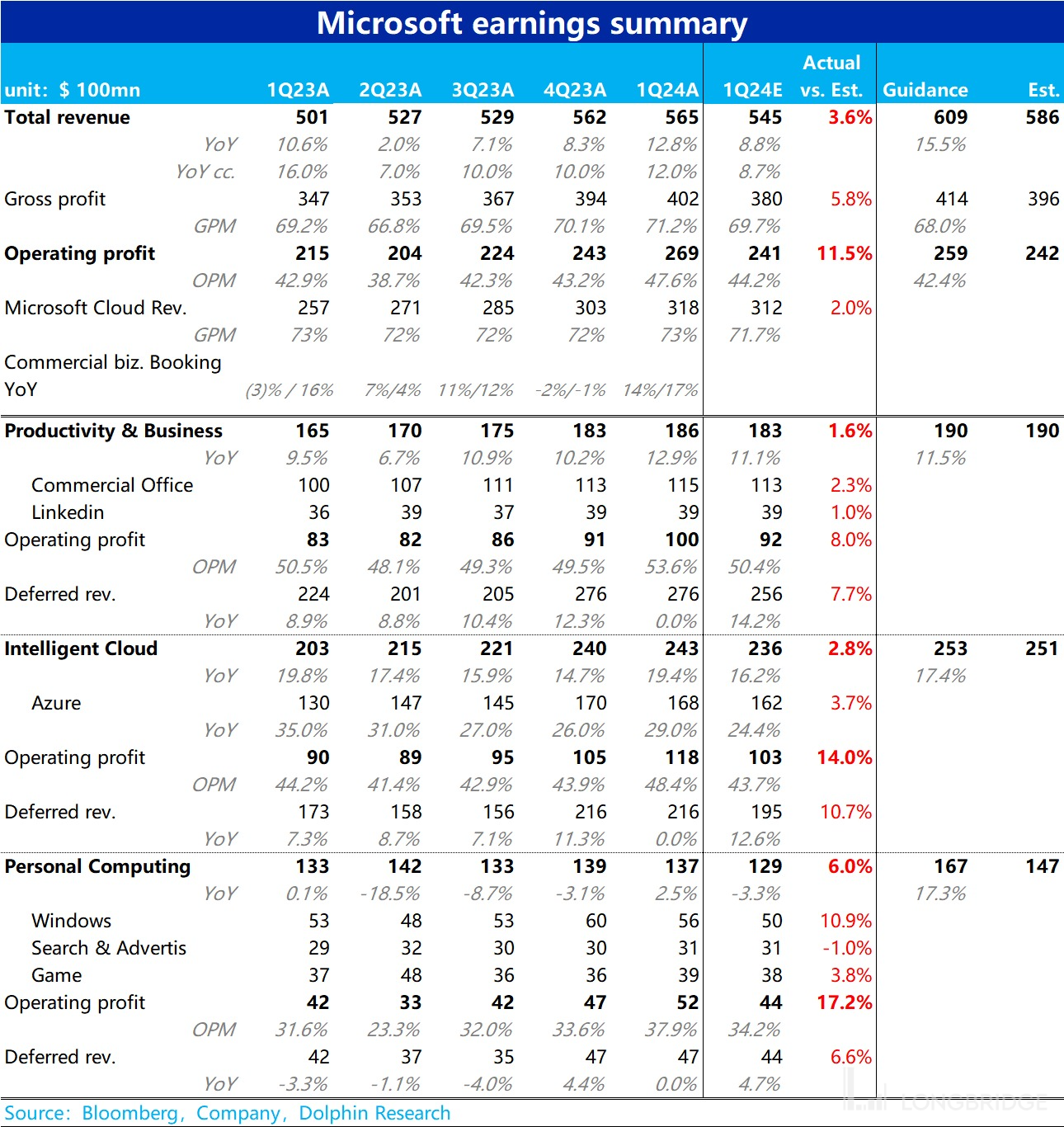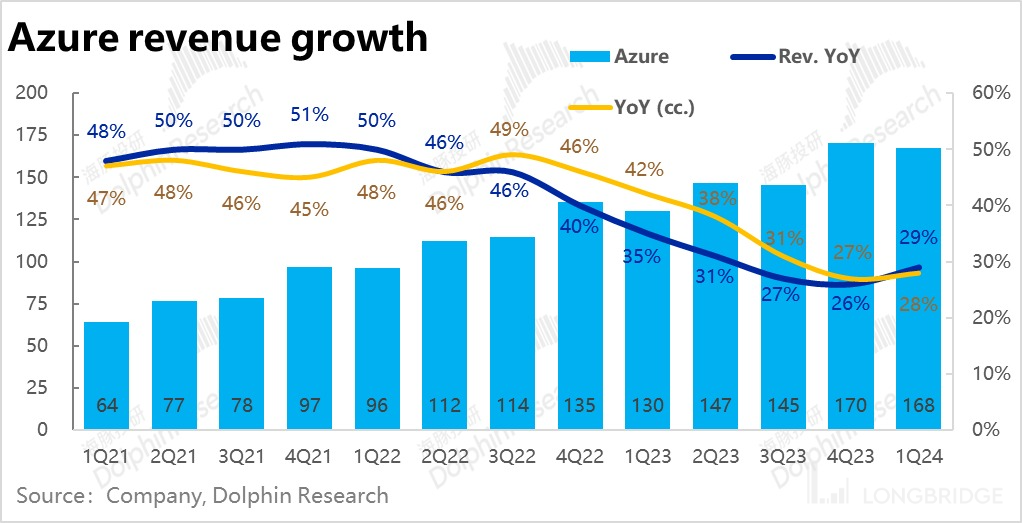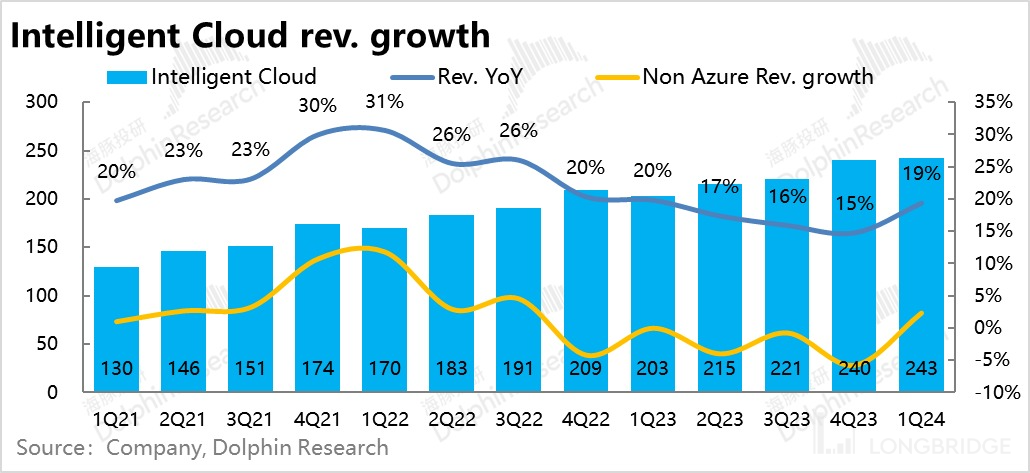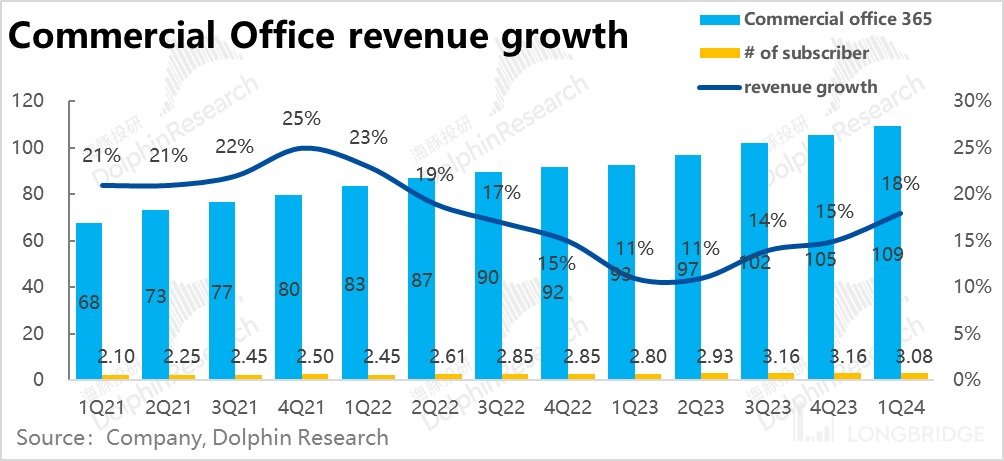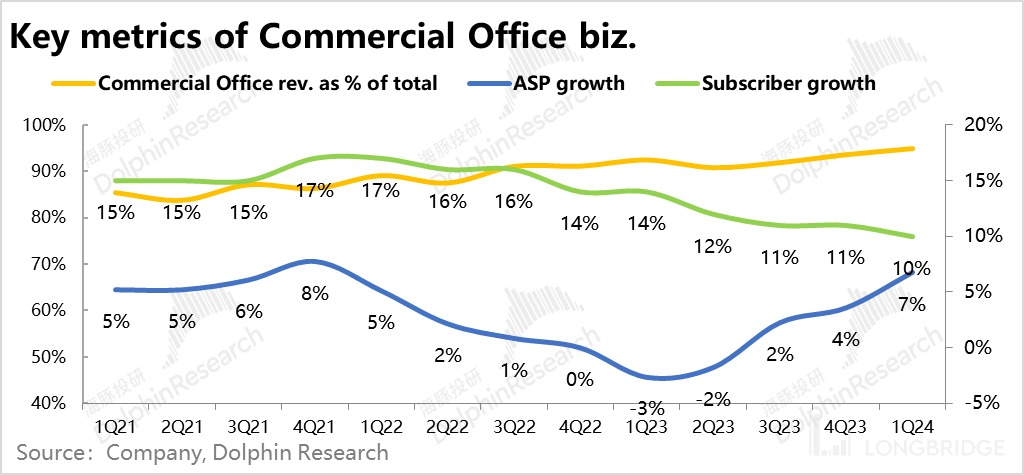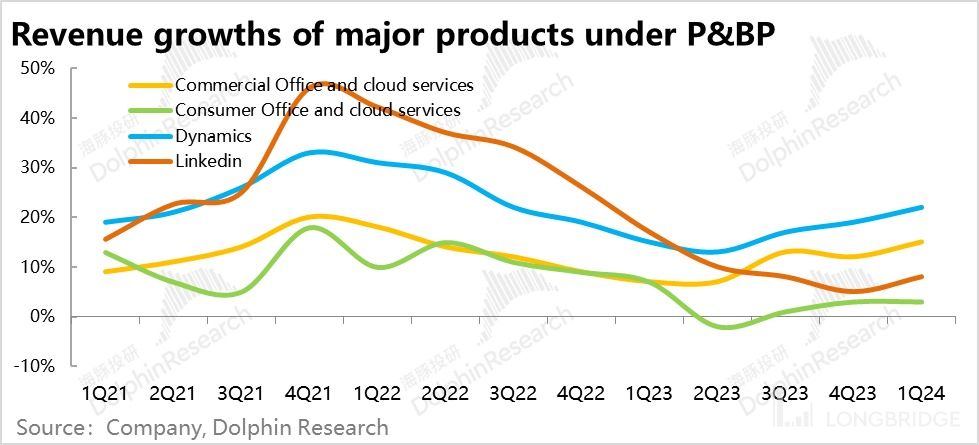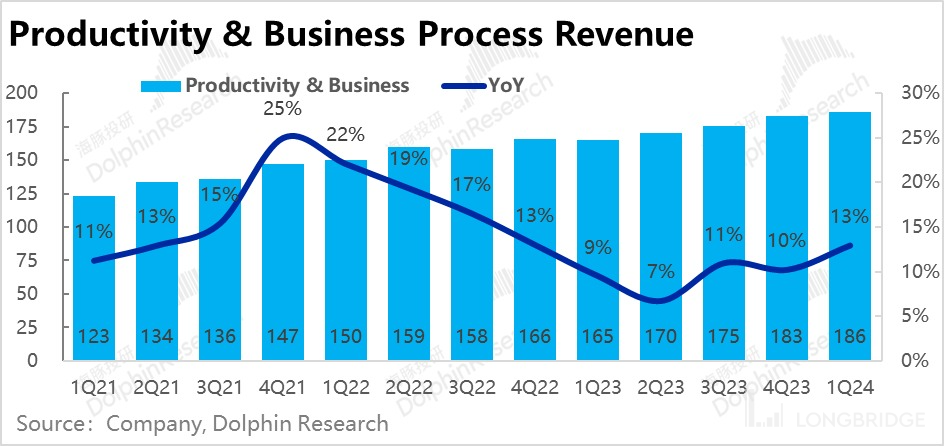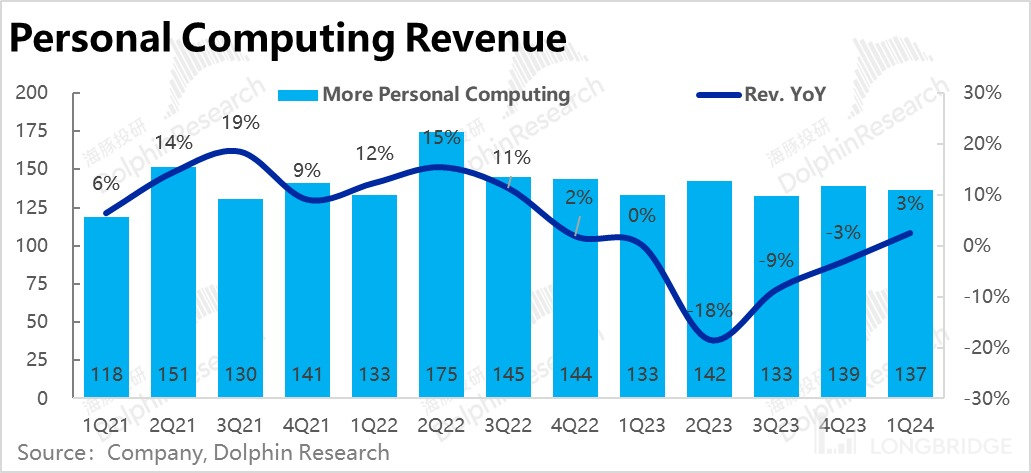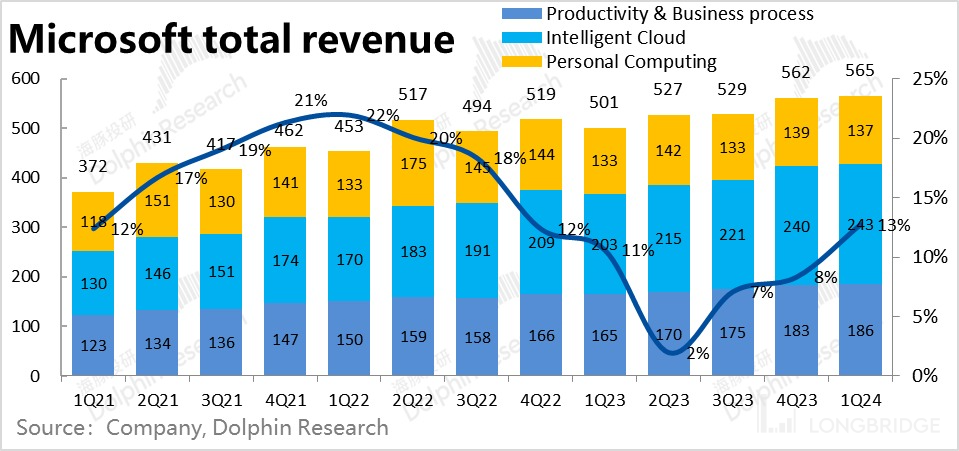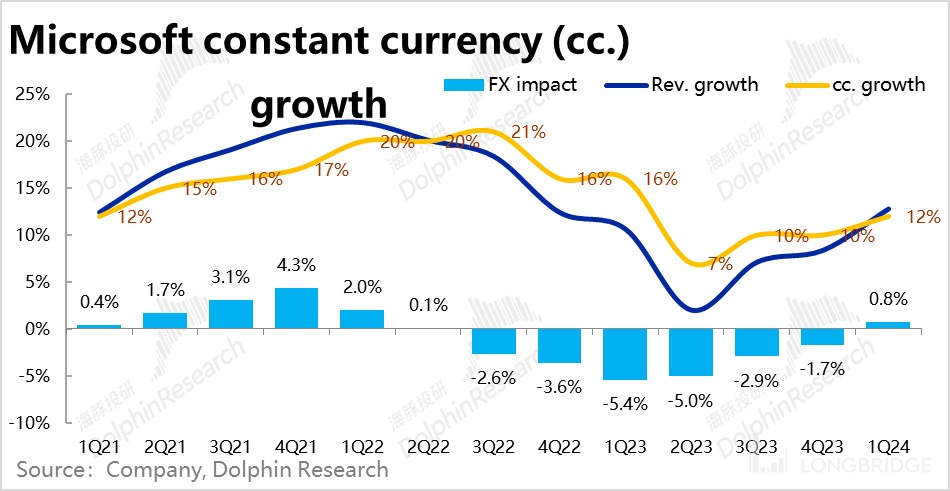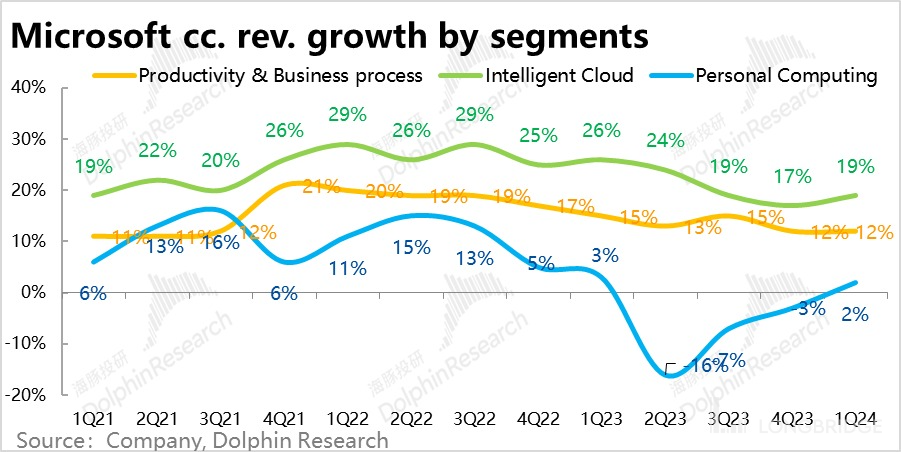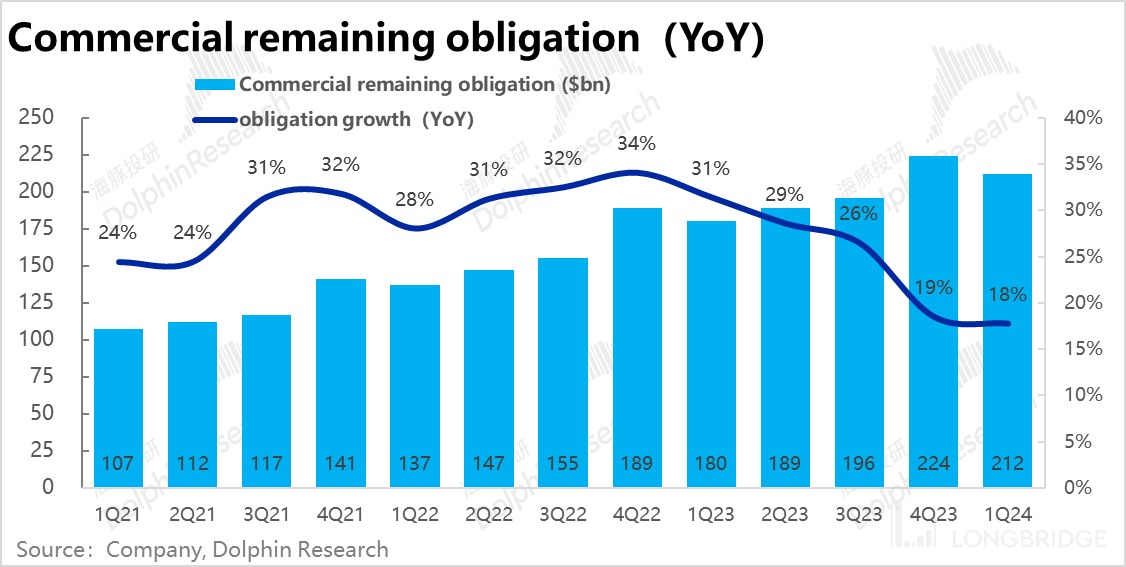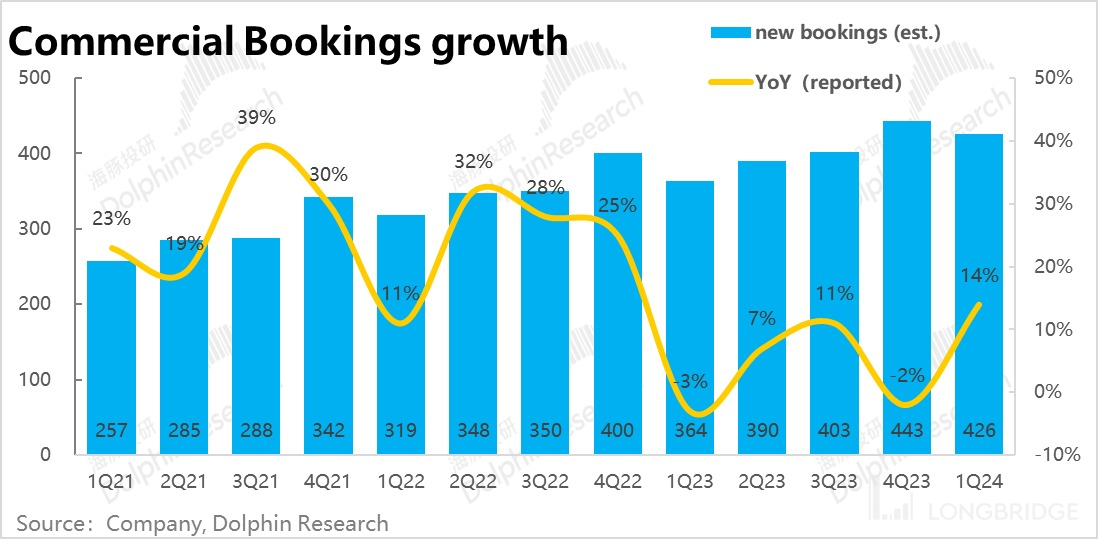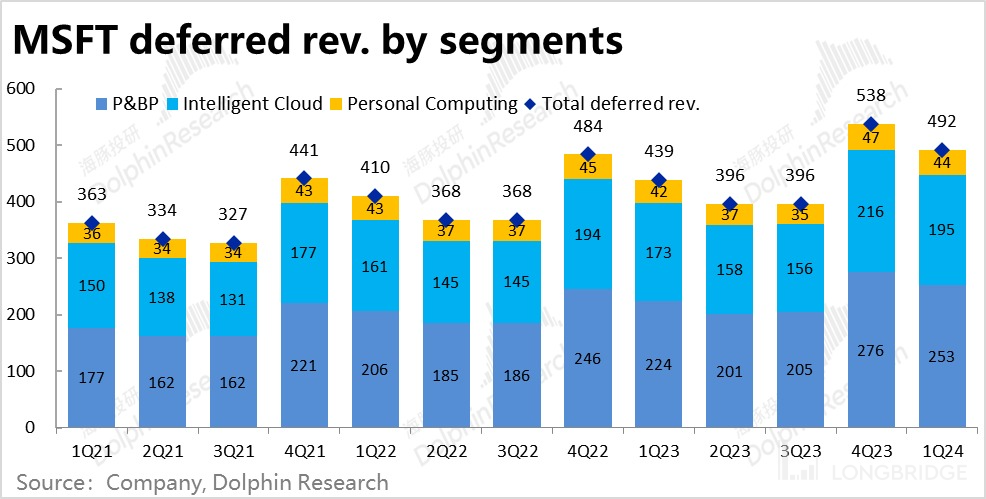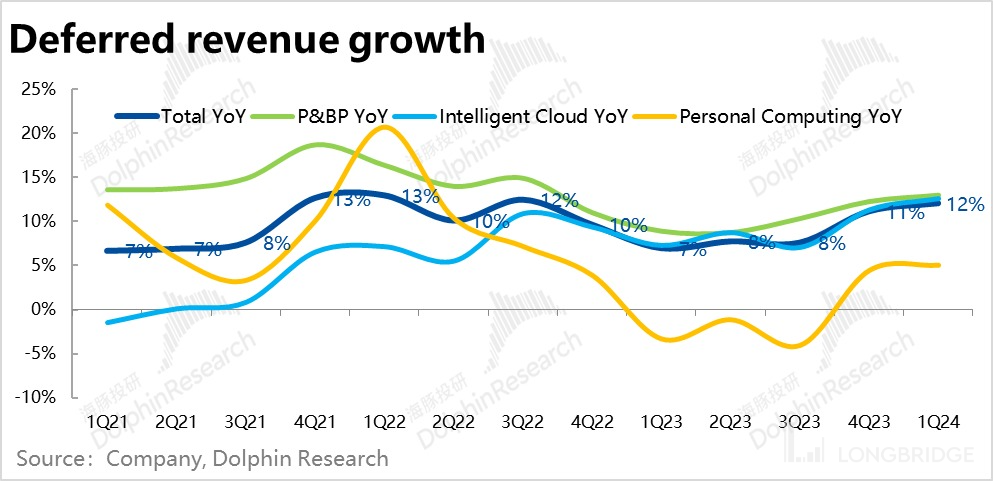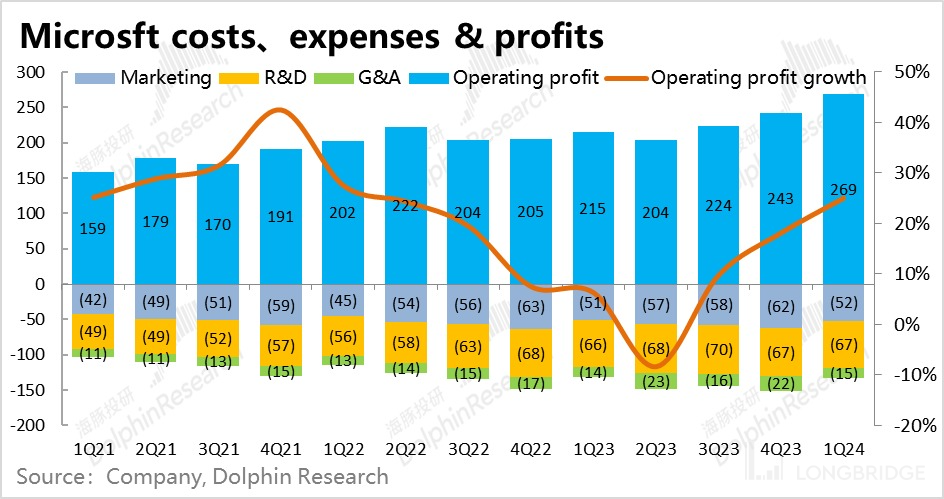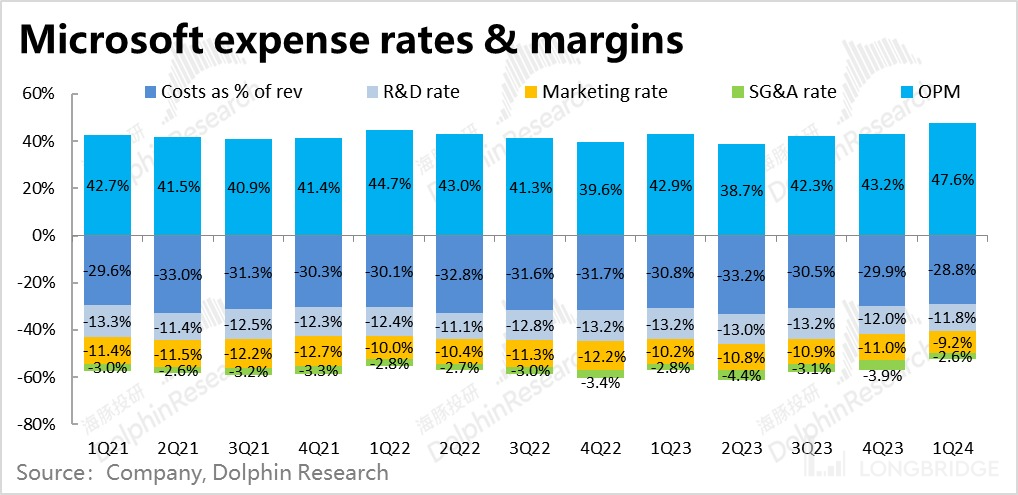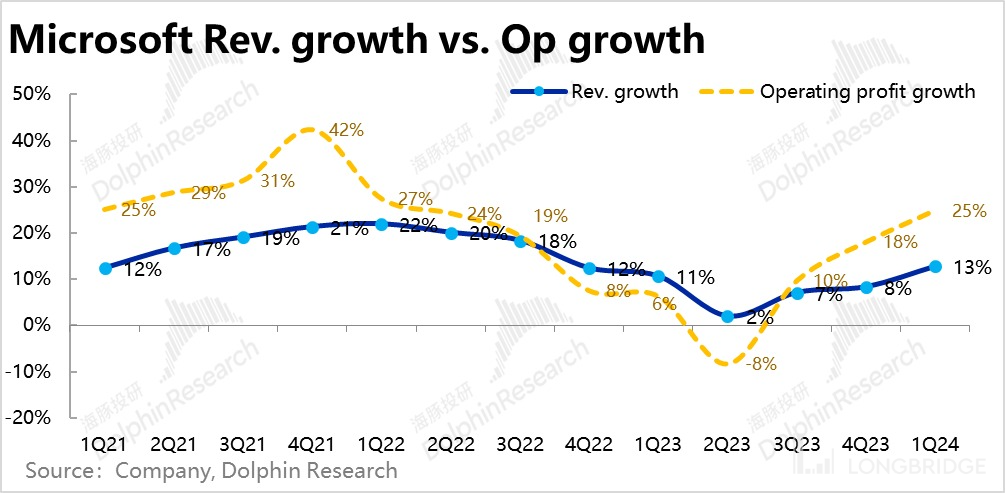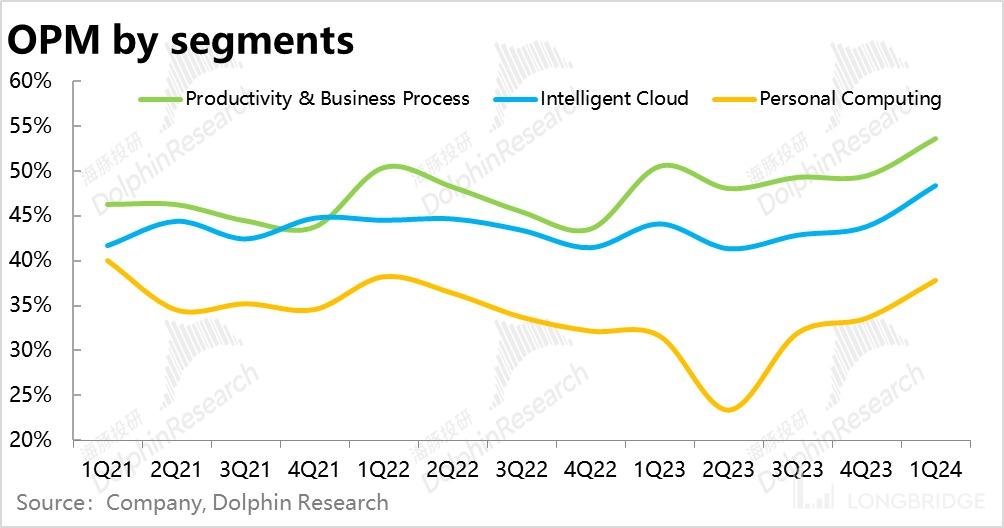
 Likes Received
Likes Received Posts
Posts"AI" Microsoft is here, is the Internet entering the Microsoft era again?

Microsoft $Microsoft(MSFT.US) announced its fiscal Q1 2024 earnings report after the US stock market closed on October 25th. The company's performance in terms of revenue and profit was impressive, with the following key points:
1.Revenue growth rebounded, and profit release was strong: In terms of overall performance, Microsoft achieved revenue of $56.5 billion this quarter, significantly surpassing the market's expectation of $54.5 billion. The year-on-year growth rate also increased from last quarter's 8.3% to a substantial 12.8%, marking the formal establishment of a turning point in growth recovery. With the gradual introduction of AI features driving product gross margin and the continued release of cost reduction benefits, Microsoft's operating profit this quarter reached $26.9 billion, far exceeding the market's expectation of $24.1 billion. The operating profit margin increased by 4.4 percentage points compared to the previous quarter. Microsoft, which can achieve higher profit growth in the long term despite not having a high revenue growth rate, has officially made a comeback.
2.AI begins to deliver, has the reversal of cloud computing demand arrived? The core business segment achieved revenue of $16.8 billion this quarter, with a year-on-year growth rate that finally accelerated to 29% after seven consecutive quarters of slowdown. Although there were impacts from the base effect and the shift from negative to positive impact of the US dollar exchange rate, this significant growth reversal implies two key events: 1) The AI wave, which has been one of the main investment themes in the market this year, has finally brought actual incremental demand for cloud computing to enterprises and driven the growth of cloud service providers' revenue; 2) The cycle of cost reduction and efficiency improvement by European and American companies, which has led to a reduction in cloud computing usage, has come to an end in recent quarters. At least one of these two significant events has occurred, or perhaps both.
Due to the recovery of cloud computing demand, the Intelligent Cloud segment achieved overall revenue of $24.3 billion, with a year-on-year growth rate that increased from 15% to a noticeable 19%, surpassing the company's guidance and the market's expectation of $23.6 billion.
3.Office Copilot boosts stable Office business volume with price increases: In another core business segment, Enterprise Office 365 achieved revenue of $10.9 billion this quarter, with a continued increase in year-on-year growth rate by 3 percentage points to 18%. In terms of price and volume breakdown, the number of Enterprise Office 365 subscription customers only increased by 10% year-on-year, indicating that the growth in user base has reached its peak and is difficult to change. However, in terms of price, the average revenue per Office 365 customer increased by 7% year-on-year this quarter. The main contribution came from the launch of high-priced AI features such as Copilot, which enabled Office to continue driving revenue growth by promoting new features and corresponding price increases, even in a situation where user growth is limited.
4. Therefore, the overall revenue of the Productivity and Business Processes (P&BP) segment reached $18.6 billion this quarter, with a year-on-year growth rate that also increased by 2 percentage points, indicating signs of recovery. This figure was higher than the previous guidance and the market's expectation of $18.3 billion. 4. Personal PC business hits rock bottom and rebounds the strongest: The previously "worst" personal PC business has experienced several quarters of negative growth, but its performance has rebounded even more strongly. This quarter, the sector achieved revenue of $13.7 billion, with a growth rate of 3%. Actual revenue exceeded market expectations by nearly $800 million, the highest surprise among the three major sectors, changing from a drag to a major contributor to exceeding expectations. Specifically, the revenue growth of the Windows business and Xbox gaming business rebounded rapidly, while the recovery of hardware and Bing advertising business was relatively slow.
5. Increase in external product prices and cost reduction internally, significant increase in operating leverage: In terms of revenue, Microsoft's growth has shown a good recovery, but the improvement in profitability this quarter is even more significant.
In terms of gross profit, Microsoft's gross margin increased to 71.2% due to the increase in the proportion of high-margin businesses in the revenue structure and the price increase of cloud computing and productivity-related products after the launch of AI features, an increase of a full 1-2 percentage points compared to the previous quarter.
In terms of expenses, the marketing expense ratio this quarter was only 9.2%, the first time it has been below 10% since 2021, and the decrease is most significant. The research and development expense ratio and administrative expense ratio continue to decrease as revenue growth recovers. The company's cost reduction and efficiency improvement efforts have shown more significant benefits to the company's operating leverage and profitability as growth recovers.
6. Guidance for the next quarter: In terms of performance guidance for the next quarter, there is not much difference between the expectations of the Intelligent Cloud and Productivity segments and the market, but the year-on-year growth rate is slightly lower compared to this quarter. However, the personal computing business continues to recover significantly, with revenue guidance for the next quarter reaching $16.7 billion, far exceeding the expected $14.7 billion.
In terms of profitability, it continues to outperform revenue. Although the operating profit margin is expected to decrease compared to this quarter due to the increase in the proportion of the personal computing business, the profit amount is expected to reach $25.9 billion, significantly exceeding the market's expected $24.2 billion.

Longbridge Dolphin Research's viewpoint:
Overall, Microsoft's revenue growth this quarter continues to show a trend of sustained recovery, and the turning point of Microsoft's growth has been officially established. In addition, the continued effectiveness of cost reduction and efficiency improvement has resulted in better improvement in profitability than revenue. Therefore, Microsoft's performance in both topline and bottom-line in this quarter is commendable.
More importantly, the AI business that the market has always highly praised, which previously did not show actual contribution to the company's performance, has finally been realized after Microsoft officially launched multiple Copilot features. This is reflected in the better-than-expected revenue growth of the cloud computing and productivity segments. It validates and opens up the market's imagination for the future performance increment of AI features. However, we can also see that the after-hours market's response to Microsoft's flawless performance was not enthusiastic. The after-hours increase is less than 4%. Dolphin Research believes that this is due to two reasons. First, in the guidance for the next quarter, the core Intelligent Cloud and Productivity segments did not exceed expectations, and the revenue growth rate did not continue to accelerate as indicated. The second reason is that Microsoft's current valuation has already incorporated a considerable amount of expectations for AI-related performance growth. In other words, this earnings report mainly validates and digests the market's existing expectations for AI, but there are no obvious points that exceed expectations.
Therefore, Dolphin Research believes that whether Microsoft can further strengthen in the future depends on factors such as the macroeconomic situation and interest rates in the US stock market, as well as the true value of AI.
Here is a detailed analysis of the earnings report:
I. Core Business: Long-awaited Recovery Finally Arrives
1.1 Azure Growth Rises Amidst the AI Wave
Microsoft's flagship product in the Intelligent Cloud business, Azure, achieved revenue of $16.8 billion this quarter, with a year-on-year growth rate of 29%, after a continuous slowdown in growth for 7 consecutive quarters. Although there are favorable marketing effects due to exchange rates, the true growth rate of Azure under constant exchange rates has also increased by 1% compared to the previous quarter.
Despite the stabilizing rebound in growth due to the declining base, this reversal signifies two things: Firstly, one of the main themes that the market has been focusing on and investing in this year, the AI wave, has finally brought more demand for cloud computing and reflected in the company's performance. Secondly, the cycle of European and American companies reducing cloud computing usage to cut costs and increase efficiency in the past few quarters has come to an end. At least one of these two significant events has occurred, or both.

In addition, the non-Azure businesses within the segment (including SQL Server, Visual Studio, and enterprise consulting services) also showed a significant rebound in revenue growth, with a return to approximately 2% growth. This also indicates that the trend of enterprises reducing cloud computing-related expenses has reversed.
Due to the rebound in growth of both Azure and other businesses, the Intelligent Cloud segment achieved a total revenue of $24.3 billion this quarter, with a year-on-year growth rate of 19%, surpassing the company's guidance and the market's expectation of $23.6 billion.

1.2 Copilot Boosts Office's Recovery Second, the company's other core business, Enterprise Office 365, achieved revenue of $10.9 billion this quarter, with a YoY growth rate of 18%, which continued to increase by 3 percentage points. Although the same period last year was the lowest point in terms of base, the actual growth rate, excluding the impact of exchange rates, was slightly lower at 17%. However, the trend of growth recovery is certain.

From the perspective of quantity and price: 1) This quarter, the number of Enterprise Office 365 subscribers increased by 10% YoY, showing signs of slowing down compared to the previous quarter. It can be seen that the trend of reaching the peak in user volume cannot be changed, and it is difficult for the Office business to rely on quantity to drive growth.
From the perspective of price, the average revenue per user (ARPU) of Office 365 increased by 7% YoY this quarter. Although the same period last year was the lowest point in terms of base, our calculations show that the ARPU increased by more than $2. Dolphin Research believes that the significant increase in the average revenue per user of Office, driven by the pricing of Office Copilot, which far exceeded market expectations, and the AI wave has also begun to contribute significantly to the performance of the Office business.

As for other businesses in the productivity segment:
① Similar to the Enterprise Office business, the Dynamics business also showed a trend of continued revenue growth recovery, reaching 22% this quarter.
② Even after considering the favorable impact of exchange rates, the revenue growth of the Linkedin business has also recovered to 8%.
③ Only the Personal Office business continues to show weak growth.

Due to the recovery of core businesses such as Enterprise Office and Dynamics, the overall revenue of the Productivity and Business Processes (P&BP) segment reached $18.6 billion this quarter, with a YoY growth rate of 2 percentage points. Slightly higher than the previous guidance and market expectations of $18.3 billion.

II. the Personal Computing business exceeded expectations in its recovery.
In addition to the recovery of core businesses, the previously worst-performing Personal Computing business also showed an unexpected recovery. The Personal Computing segment achieved revenue of $13.7 billion this quarter, and the growth rate finally turned positive at 3%. In terms of expectations, the actual revenue exceeded market expectations by $800 million, making it the segment with the highest revenue exceeding expectations among the company's three segments.

Looking at the specific breakdown, 1) Windows OEM business revenue has rebounded by 4% YoY;
Hardware sales, mainly from the Surface product line, have declined significantly by 22%;
The growth rate of Xbox software and content revenue in the gaming business has recovered to 13%;
However, the growth rate of the advertising business, which is more closely related to macroeconomic conditions, has only slightly increased from 8% in the previous quarter to 10%. After excluding the impact of exchange rates, the growth rate remains flat.
III exchange rates have changed from a drag to a positive factor, but the trend of performance recovery is certain.

Overall, Microsoft achieved revenue of $56.5 billion this quarter, significantly higher than the market's expectation of $54.5 billion. All three major segments slightly exceeded expectations, mainly due to the contribution from the personal computing business, with a YoY growth rate increasing from 8% in the previous quarter to 13%.
After excluding the impact of exchange rates, the actual growth rate is 12%, indicating a positive impact of nearly 1 percentage point from exchange rates. Even under the assumption of constant exchange rates, the revenue growth rate this quarter has accelerated by 2 percentage points, confirming the recovery in growth rate.

Looking at the real growth rate of the three major segments after excluding the impact of exchange rates, there has indeed been an improvement in the growth rate of the Intelligent Cloud and Personal Computing businesses. However, the growth rate of the Productivity and Business Processes segment has remained relatively stable.

In summary, most of Microsoft's business segments have shown signs of recovery in revenue this quarter.
iiii. So, how is the performance of various "residual" data that reflects future growth?
First, let's look at the long-term "residual" data of the to B business contract balance. The "unfulfilled contract balance" (deferred revenue + contracted but not yet invoiced amount) at the end of this quarter is $212 billion. Due to seasonal factors, it has once again declined MoM, and the growth rate has continued to slow down to 18%, still at a historical low. There doesn't seem to be any significant improvement in the long-term "residual" data.

And reflecting the increase in new business contract amounts for the quarter, there has been a decent growth, with a YoY increase of 14%. Although last year's same period served as a favorable base, it can still be seen that there has been a recovery in new cloud computing and other IT expenditures this quarter.

And the more certain short-term "reserves" - deferred revenue for this quarter reached as high as $49.2 billion (the majority of which will be recognized as revenue within a year), with a YoY growth of 12%, slightly higher than the previous quarter, which is consistent with the trend of revenue growth.

Looking at it in more detail, the growth rate of deferred revenue for each segment has also improved MoM, but the improvement in deferred revenue for the personal computing business, which had the best revenue recovery for the quarter, has been relatively slow.

V. Strong growth recovery, and even stronger profit rebound
In terms of revenue, the contribution of the AI wave to the company's performance has finally been demonstrated, and revenue growth in each segment has been restored. However, with the company actively reducing costs and increasing efficiency, and the help of the reversal of inflation and the impact of the US dollar exchange rate, Microsoft's profit improvement this quarter is the most significant.

This quarter achieved a gross profit of $40.2 billion, with a gross profit margin significantly improved to 71.2%, showing considerable improvement YoY and MoM. According to the company's explanation, the continuous improvement in gross profit margin over the past two quarters is mainly due to the increased proportion of high-margin businesses in the company's revenue structure, as well as price increases for cloud computing and productivity products after the launch of AI capabilities.
In terms of expenses, all three categories of operating expense ratios have decreased MoM. Among them, the marketing expense ratio for this quarter is only 9.2%, the first time it has been below 10% since 2021, and the decrease is most significant. The research and development expense ratio and the administrative expense ratio have also slightly decreased. It can be seen that the company's efforts to reduce costs and increase efficiency are still paying off.

Finally, Microsoft's operating profit for this quarter reached $26.9 billion, with a YoY growth rate of 25%, far exceeding the market's expected operating profit of approximately $24.1 billion. The growth rate of the company's operating profit once again far exceeds the growth in revenue. Microsoft has returned to a trajectory of achieving stronger profit growth in the long term through economies of scale and product price increases, relying on revenue growth that is not particularly high.

Specifically, the profit margins of each segment have improved significantly, with the MoM increase ranging from 4% to 5%, showing a similar level of improvement. In terms of absolute profit values, the Intelligent Cloud and Productivity segments contributed 11.8 billion and 10 billion respectively, while the Personal PC business contributed less, approximately 5.2 billion. Compared to market expectations, the actual performance of each segment exceeded expectations by around 1 billion.


Dolphin Research's Microsoft research reports:
Earnings Report Analysis:
- July 26, 2023: Microsoft: All in AI (Conference Call)
- July 26, 2023: The Reality of Microsoft's AI Vision (Earnings Report Analysis)
- April 26, 2023: The Impact of AI on Microsoft's Performance (Conference Call)
- April 26, 2023: Can Microsoft Leverage Chatgpt to Soar Again? (Earnings Report Analysis)
- January 25, 2023: Inevitable Slowdown (Summary of Microsoft Conference Call) (Conference Call)
- January 25, 2023: Azure's Resilience Can't Save Microsoft in the Economic Downturn (Earnings Report Analysis)
- October 26, 2022: Can Microsoft Safely Navigate the Economic Downturn? (1Q23 Conference Call Summary) (Conference Call)
Risk Disclosure and Statement of this Article: Dolphin Research Disclaimer and General Disclosure
The copyright of this article belongs to the original author/organization.
The views expressed herein are solely those of the author and do not reflect the stance of the platform. The content is intended for investment reference purposes only and shall not be considered as investment advice. Please contact us if you have any questions or suggestions regarding the content services provided by the platform.

